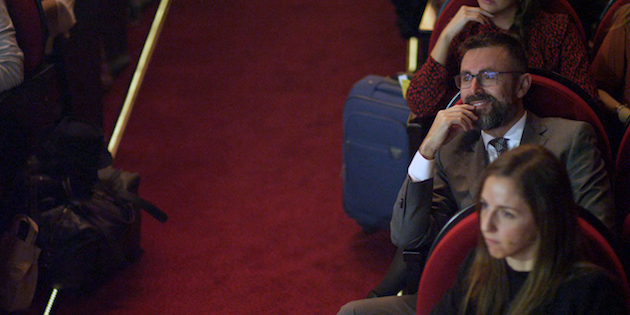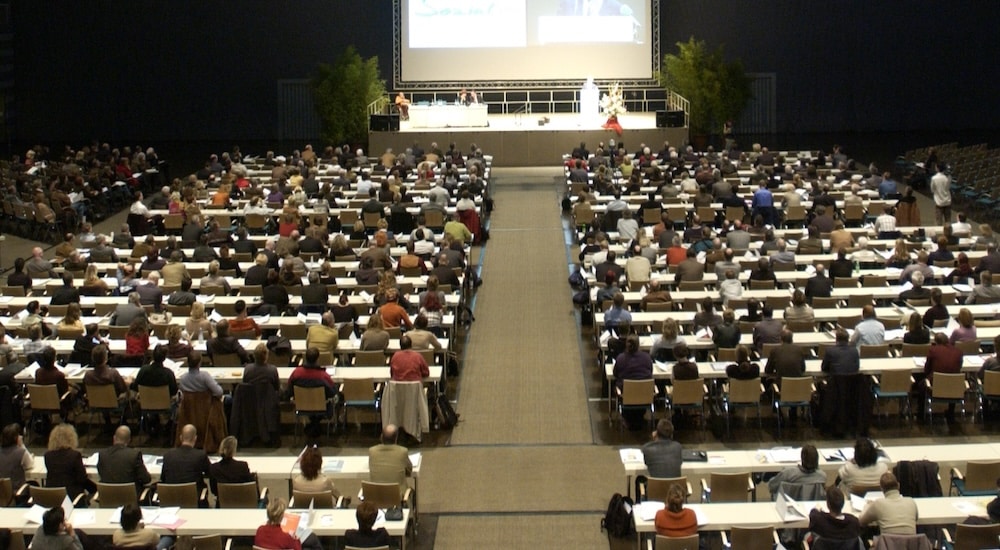Crossover learning for professional associations: periodontology to audiology
professional strategies
Crossover learning can benefit all areas of medicine and healthcare, including audiology. One of those key areas is the organisation and motivation of sector professionals. What, for example, might associations in audiology learn from its points of convergence with the branch of dentistry known as periodontology?

In 2010, shortly after Javier García took on his marketing and communications role for the Spanish Society of Periodontology and Osseointegration (SEPA), this professional association boasted 2450 members. Only 621 delegates attended its annual congress that year in Girona, Catalonia, even though this would still be a good turn-out today for many national European hearing healthcare congresses.
Fast forward to 2019, and the association, under García’s guidance as Executive Director, embraces 6049 members, pulling a staggering 6290 delegates to its deluxe SEPA Valencia gathering (over 50% more, for example, than the global American Academy of Audiology annual conferences, and not too far off the 8,000 who gather for the annual EUHA International Congress of Hearing Aid Acousticians). How can this be?
UK audiology magazine, Audio Infos, crossed the divide between countries and healthcare tribes to interview this Spanish marketing and communications guru working in the dental discipline of periodontology. Here, the thoughts of Javier García Gómez-Die are laid bare on focusing health, thinking globally, and the keys to building a rock-solid professional association.
Audio Infos: What were the keys to your conversion of SEPA into an association admired not only in Spanish and world dentistry, but also in other healthcare spheres?
Javier García: The answer to that can be synthesised by the three words that we could have as the vertices of a triangle: health, science, and clinical practice. These three concepts cover three essential principles: The first involves placing health at the highest point of the pyramid, with the human and civic component as a guideline for action, in other words the promotion of health as the beginning and end of advances in science and their clinical applications, and with a positive focus based on achieving the absence of any pathology.
The second is science. This involves cementing any hypothesis or chosen stance through scientific evidence. And this is done via close cooperation with universities, principally, and researchers, by taking on the role that can be fulfilled as a promoter of research and, above all, as a leading body in the transference and communication of scientific knowledge arrived at through rigour.
The third is clinical practice. This is about recognising that, if science manages to create and safeguard health, the environments for clinical intervention and attention must be nourished by knowledge, tools, and systems that enable interaction with the patient, and from a therapeutic perspective based on excellence and oriented towards prevention, and even towards promotion of health based on scientific evidence. These three principles help to get across the goal of SEPA, which is the scientific development of periodontology and dentistry alongside the promotion of oral and general health.
Objectives and priorities
AI: How does an association achieve its objectives?
JG: With work, and a great deal of teamwork. And a combination of institutional vision, information and promotional foresight, of both government agencies and how to participate in them, and with professional management teams. Actions and campaigns that have worked well for SEPA have been, obviously, the Oral Health Congress, the Alliance for Oral and General Health, our gumcare magazine for patients, Cuida tus Encías. These have opened up cooperation with other players, as well as boosted institutional sustainability, avoiding superfluous conflicts; and for the European Federation of Periodontology, the greatest banners have been the EuroPerio congress, the Journal of Clinical Periodontology, and the Periodontology Workshop, the creations of a network of accredited European Postgraduate Courses, and Gum Health Day.
AI: So, are you saying that having well-defined missions and projects will help keep the boat on course?
JG: Institutional sustainability enables conceptualisation of projects and the acceptance by the leaders of risks, given that they work in a climate of trust, which favours innovation.
A seemingly supefluous but revealing example: in an institutionally stable climate, and with the relevant opinion leaders supporting the leadership, we proposed the creation of a scientific information channel through internet-based television. It was accepted. When a change of leaders came through, those leaders who felt they were losing control opposed the same project they had backed just a year before. An organisation is a system in which everything must flow. The work of the leadership consists of preventing and avoiding blockages in relationships that allow the system to function. So, the model for governance and institutional stability is vital in a non-profit organisation. Sharing values, culture, and experiences helps.
AI: Within the global management vision of a professional association, what should take priority? Communicating messages to the public? The image of professionalism, or perhaps glamourising the profession? Other things?
JG: Everything is important. The global vision of a professional body must turn 360 degrees, with full awareness of what the body’s stakeholder map looks like, and what its value proposition is, what the motive and reasoning is for asking professionals to form part of a project and give their time, devotion, and even resources to it. Of prime importance too is the reason that justifies our asking the public to pay attention. Asking all these questions is crucial, practically vital.
AI: How can you maintain a balance between, on the one side, scientific and medical investigation, and on the other, business interests and pressures from manufacturers?
JG: Always by putting the common interest first, the scientific foundation, and the vision of professionals, patients and society as a whole.
Exportable strategies
AI: You have worked at all levels in European dentistry—in Spain with SEPA, and running communications for the European Federation of Periodontology—and you have seen very different professional panoramas in each territory. Are there any obvious models to follow, and why?
JG: Europe, USA, and Latin American countries do indeed present differently nuanced variations culturally, economically, legally, and socially. Rather than point to any as a model to follow, I prefer to point out the positive elements of each area or country, identifying the intersections that grow stronger through mutual cooperation. The most important thing is that the models for transmitting knowledge are open and horizontal. The more meaningful the information shared, the greater the value we create and the more quality output we spread around. Cascading pyramid mechanisms are no longer sustainable. But there are still people around who want to base power on control. This is not possible. Hierarchies have been blown clean away, in spite of current populist trends. The bodies that have democratised rigorous scientific content are becoming the guiding stars, equally for professionals, patients, and the community at large, in fact for all the interest groups in each knowledge area.
What is important are the models and systems for accessing and abandoning power, as well as participation and visibility in the different strata of a scientific body, integrating all sensibilities and nuclei of power, and consolidating both gender and inter-generational perspectives. In a non-profit making body, the biggest asset for generating value is its relational and intellectual capital.
AI: Throughout your years working in periodontology, what have you learned from comparing the structures and dynamics of that professional world with those of neighbouring healthcare fields?
JG: For me, the most important learning experience has come from verifying that opportunities and risks are very similar. On the positive side, the bodies that focus on the common interest, and that blend scientific and institutional leadership with a view to professionalisation based on strategic vision, can multiply their potential for social transformation, becoming fundamental players in getting across scientific content and in training professionals. They can then articulate and sharpen the point of belonging to a community based on the common interest.
On the negative side, those bodies that get lost down blind administrative alleyways gradually lose their potential, falling into the risk of disappearance or insignificance.
AI: What approaches by SEPA are exportable to other associations, such as those in UK audiology?
JG: Science is the keystone, the beginning. Without solid knowledge it is very difficult to build a project into a public benchmark. In this respect, at SEPA we have made a strong commitment to links with universities and with the leaders of teams that harvest knowledge.
AI: And exportability in terms of a global projection?
JG: Right now, every organisation and every person is global, and they are interconnected whether they want to be or not, and wherever they are located. Internet is behind this. Knowledge knows no frontiers. In this regard, SEPA has taken on the role of a frontline hub within a global setting, first as a bridge between Europe and Latin America, then connecting with the USA, and more recently also with the Middle East. It is only a question of time before we are working too with Africa and Asia.
AI: And what about SEPA’s breakthroughs in interdisciplinary dialogue and sharing of knowledge across frontiers traditionally jealously guarded?
JG: Interdisciplinary and multidisciplinary focuses are essential, for two reasons: first, because they enable the widening of horizons in the areas of work and social legitimacy; and secondly because they represent a vast source for learning.
So, here we have been involved in a successful multidisciplinary experience, namely the Alliance for Health, in which we have worked closely together with other professionals in medicine through societies in cardiology, diabetes, gynaecology, and primary care, among others. And the interdisciplinary dimension of dentistry has opened out by identifying the message that can be shared from periodontology to other dental disciplines such as orthodontics, dental prosthetics, and endodontics, among others.
AI: And in terms of integrating and professionalising all levels and ages within the Association’s reach, from students to dental auxillaries, even to dental admin personnel?
JG: Indeed, segmentation of interest groups this body relates with is highly important, especially segmentation of the beneficiaries of activities. This led to SEPA presiding the Oral Health Congress, which brings together SEPA Periodontology, SEPA Interdisciplinary, SEPA Hygiene, SEPA Management, and SEPA Digital.
AI: What about the importance and meaning of meetings?
JG: This is another key point. In this sense, we made efforts to create symbols and spaces for gatherings, both from a social perspective and based on knowledge. We are currently immersed in a process of segmentation of content and the communities that enable dialogue, and a cross-cutting vision of knowledge.
AI: What value do you give to training, one of the main activities of most professional associations?
JG: Training is a means for getting science across to professionals. Sights should be set on patients and the end users of the sophisticated techniques and technology that research and business can provide.
Science with a capital S
AI: It looks like the leadership composition in SEPA has been dominated by individuals of a scientific tenor, and you have stressed that ˝science is the keystone˝, so should the leadership of a healthcare association weight its powers towards people with science training rather than business or admin backgrounds?
JG: The important thing in an organisation is its purpose and frame of reference. If we are talking about a scientific body, then its frame of reference must be science. This forms its basis and multiplies its scope. It helped the formulation of SEPA’s aim: Peridontology for All. And from the science basis of periodontology, we expanded that to clinical application and its impact on quality of life and the health of the population: Periodontology and Oral Health for All.
Even in the coming years, at least in Spain, that purpose must be extended again beyond periodontology to take in dentistry as a whole. So, the scientific foundation means we can clearly identify the sphere for action and the commonalities with other bodies and actors. The leadership can lean towards a scientific make-up, or clinical. It is good for there to be a combination between the scientific and clinical spheres, given that each complements and strengthens the other. This equilibrium is a great stronghold that also links to institutional sustainability.
Javier García’s connection with the world of periodontology began in 2009. Since then he has worked with the Spanish Society of Periodontology and Osseointegration (SEPA), creating the SEPA Foundation in 2012, a body with the vision and capacity to operate at a global level. With this as a firm anchor, he was able to contribute to the modernisation of the European Federation of Periodontology from 2012 to 2019, as well as the Ibero-PanAmerican Federation of Periodontology from 2018, providing specific consultancy services also to periodontology services in the UK, Israel, Belgium, Turkey, and Italy, among others.
In the world of medicine, different experiences have led to him collaborating at intense levels with colleges and associations in cardiology, diabetes, digestive medicine and, in particular, the family practice territory of the GP. His professional experience has been expanded and fortified through key involvement in the forming of international associations, scientific societies, and bodies focused on social innnovation.
At the present time, in addition to his role as Executive Director of SEPA, Javier García Gómez Die is Adjunct Professor of Branding and Corporate Communications at the University of Alicante, Spain. He is also CEO of his own marketing and communications consultancy, Eucalyptus Global Vision.
Source: Originally published in issue 134 of Audio Infos UK, March 2020







